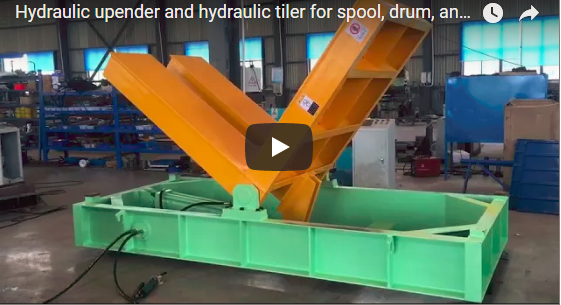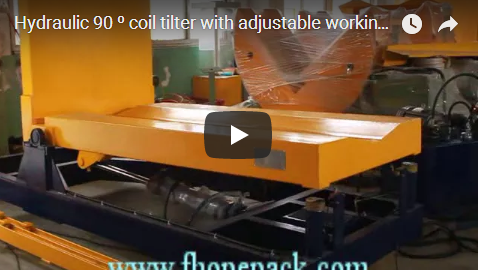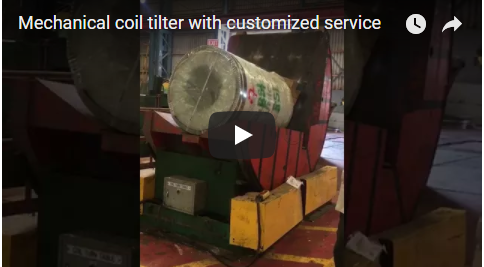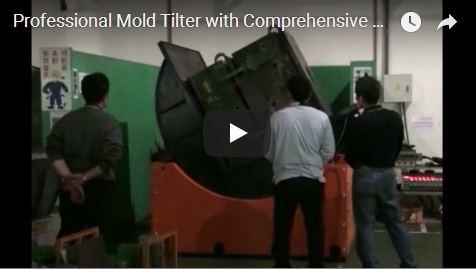Optimizing Board Bundle Handling: A Technical Look at Hydraulic Tilters with Pressing Tops
In demanding industrial environments such as wood processing, furniture manufacturing, and construction material supply, efficient and safe material handling is paramount. Board bundles – often heavy, cumbersome, and potentially unstable – require specialized equipment for rotation and repositioning. Hydraulic tilters have become indispensable tools for this purpose, significantly reducing manual labor, minimizing product damage, and enhancing operational safety. This article provides a technical deep-dive into hydraulic tilters designed for board bundles, specifically comparing models with and without a pressing top mechanism, examining their design, specifications, operational characteristics, and ideal applications.
1. Understanding the Core Technology: The Hydraulic Tilter
A hydraulic tilter, sometimes referred to as an upender or rotator, is a robust piece of industrial equipment engineered to tilt heavy loads, typically up to 90 or 180 degrees. The core system utilizes hydraulic power for controlled, smooth, and powerful movement.
1.1. Key Components and Structure
A typical hydraulic tilter comprises several essential elements:
- Structural Frame: Heavy-duty welded steel construction designed to withstand significant load stresses.
- Tilting Platform: The surface where the load (e.g., board bundle) is placed, often featuring specific designs like V-saddles or flat platforms depending on the application.
- Hydraulic Power Unit (HPU): Includes an electric motor, hydraulic pump, reservoir tank, valves, and filters, generating the necessary hydraulic pressure.
- Hydraulic Cylinders: Actuators that convert hydraulic pressure into linear force, driving the tilting motion of the platform.
- Control System: Typically an electrical control panel with push buttons or a PLC interface for operator command, often including safety interlocks.
1.2. Operational Principle
Hydraulic fluid, pressurized by the HPU, is directed through control valves to the hydraulic cylinders. The extension or retraction of these cylinders exerts force on the tilting mechanism, causing the platform and its load to rotate smoothly around a pivot point. Precision control valves allow for variable speed and accurate positioning.
2. The Challenge: Handling Board Bundles Safely and Efficiently
Board bundles, whether composed of timber, MDF, particleboard, metal sheets, or other panel materials, present unique handling challenges:
- Weight: Bundles can weigh several tons.
- Size & Shape: Large dimensions and potentially uneven stacking can make them difficult to manage.
- Stability: Individual boards within a bundle can shift, especially during tilting, posing a significant risk of load collapse, product damage, and personnel injury.
- Surface Characteristics: Smooth or slippery surfaces can exacerbate stability issues.
Hydraulic tilters directly address these challenges by automating the tilting process, replacing risky manual handling or less stable methods like forklift maneuvering for rotation.
3. Specialized Solution: The Hydraulic Tilter with Pressing Top
For applications demanding maximum load security, particularly with board bundles prone to shifting, the hydraulic tilter with a pressing top offers an advanced solution.
![Image placeholder: Diagram or photo of a hydraulic tilter with a pressing top mechanism clearly visible. Alt text: Hydraulic Tilter with Integrated Pressing Top for Board Bundle Stabilization]
3.1. Design and Mechanism
This variant incorporates an additional hydraulically or mechanically actuated mechanism – the pressing top. This component, often a robust bar or plate, descends onto the top surface of the board bundle before or during the tilting cycle.
- Function: It applies controlled downward pressure, effectively clamping the bundle against the tilting platform.
- Mechanism: Typically driven by dedicated hydraulic cylinders or sometimes screw jacks, integrated into the tilter's overall structure and control system.
- Control: The pressing force is often adjustable to suit different load types and prevent damage to sensitive materials.
3.2. Key Components (Specific to this type)
- Pressing Bar/Plate Assembly: The structural component applying the pressure.
- Actuation System: Dedicated hydraulic cylinders or mechanical actuators for the pressing top.
- Integrated Controls: Control panel functions to activate, adjust, and release the pressing top, often interlocked with the main tilt function for safety.
3.3. Technical Data Comparison (Example Ranges)
| Feature | Hydraulic Tilter w/ Pressing Top | Hydraulic Tilter w/o Pressing Top | Units | Notes |
|---|---|---|---|---|
| Load Capacity | 1,000 - 15,000+ | 1,000 - 15,000+ | kg | Application dependent |
| Tilting Angle | 90 / 180 | 90 / 180 | Degrees | Standard options |
| Tilting Speed | 15 - 60 | 15 - 60 | Sec/90° | Adjustable, may be slightly slower w/ top |
| Platform Size (L x W) | Customizable | Customizable | mm | Based on load dimensions |
| Pressing Force | Adjustable (e.g., 1-5 Ton) | N/A | Ton (Force) | Key differentiator |
| Cycle Time | Slightly longer | Potentially shorter | Seconds | Due to extra press/release step |
| Control System | Push Button / PLC | Push Button / PLC | - | Can include automation integration |
| Power Requirements | 3 - 15+ | 3 - 15+ | kW | Higher end possible for pressing force |
| Load Stability | Very High | Moderate to High | Qualitative | Depends on load/securing |
| Initial Cost | Higher | Lower | Relative | Due to additional mechanism |
| Complexity | Higher | Lower | Relative | More components & control logic |
(Note: Values are indicative ranges and vary significantly based on specific model and customization.)
3.4. Operational Experience and Advantages
- Enhanced Safety: The primary benefit. Significantly reduces the risk of bundle collapse during tilting, protecting personnel and preventing material damage. This is crucial for compliance with safety standards like those from OSHA or equivalent regional bodies.
- Improved Load Control: Ensures precise and secure handling, even for unevenly stacked or slippery bundles. Allows for confident operation at optimal speeds.
- Versatility: Effectively handles a wider range of bundle types and stabilities compared to standard tilters.
- Reduced Product Damage: Prevents boards from shifting and damaging edges or surfaces.
- User Confidence: Operators can perform tilting operations with greater assurance of load security.
3.5. Considerations
- Higher Initial Investment: The additional mechanism increases the purchase price.
- Increased Complexity: More components mean potentially higher maintenance requirements over the long term.
- Slightly Longer Cycle Time: The need to engage and disengage the pressing top adds seconds to the overall process.
4. The Standard Solution: Hydraulic Tilter without Pressing Top
The hydraulic tilter without a pressing top represents the standard configuration, widely used across various industries.
![Image placeholder: Photo of a standard hydraulic tilter handling a stable load. Alt text: Standard Hydraulic Tilter Rotating a Securely Strapped Board Bundle]
4.1. Design and Suitability
This design relies on the stability of the load itself, friction between the load and the platform, and potentially external securing methods (like strapping) to maintain integrity during tilting.
- Simplicity: Fewer moving parts compared to the pressing top variant.
- Efficiency: Potentially faster cycle times when the pressing step is not required.
4.2. Key Components
Standard components as listed in Section 1.1, without the pressing top assembly and its dedicated actuation/control elements.
4.3. Operational Experience and Advantages
- Cost-Effectiveness: Lower initial purchase price makes it an attractive option for budget-conscious operations or applications where maximum load clamping isn't critical.
- Simpler Operation & Maintenance: Fewer components simplify operator training and reduce potential points of failure or maintenance needs.
- Space Efficiency: Often possesses a slightly smaller overall footprint.
- Ideal for Stable Loads: Performs excellently when handling tightly bound, inherently stable, or well-secured bundles where the risk of shifting is minimal.
4.4. Considerations
- Load Stability Dependency: Performance relies heavily on the inherent stability of the board bundle. Unstable or slippery loads pose a higher risk.
- Potential Need for Strapping: May require manual strapping or other securing methods prior to tilting, adding an extra operational step.
- Risk Assessment: Requires careful assessment of the load characteristics to ensure safe operation.
5. Making the Right Choice: Application-Driven Selection
Selecting between a Hydraulic Tilter for Board Bundles with or without a pressing top hinges on a thorough analysis of your specific operational requirements:
5.1. Load Characteristics:
- Unstable/Slippery/Irregular Bundles: Strongly favour a tilter with a pressing top for enhanced safety and load control. Examples include freshly sawn lumber, smooth-surfaced panels, or unevenly stacked bundles.
- Stable/Tightly Bound Bundles: A tilter without a pressing top can be a cost-effective and efficient solution. Examples include securely strapped MDF packs or uniformly stacked boards.
5.2. Safety Protocols and Risk Tolerance:
- High Priority on Safety/Zero Damage Tolerance: The pressing top provides an additional layer of security, minimizing risk. Essential in highly regulated environments or when handling high-value materials.
- Moderate Risk/Stable Loads: A standard tilter, used correctly with appropriate procedures (like pre-strapping if needed), can meet safety requirements.
5.3. Budgetary Constraints:
- Limited Budget: The standard tilter offers a lower initial investment.
- ROI Focus on Safety/Damage Prevention: The higher cost of a pressing top tilter can be justified by preventing costly accidents or material damage.
5.4. Operational Workflow and Throughput:
- High Throughput Needed: Evaluate if the slightly longer cycle time of the pressing top model impacts overall line efficiency significantly. For stable loads, the standard model might be marginally faster per cycle.
- Integration: Consider how easily each type integrates with existing conveyors, loading/unloading stations, and automation systems.
5.5. Facility Space:
- Limited Floor Space: The standard tilter generally requires less space. Ensure adequate clearance for the chosen model, including the movement arc of the pressing top if selected.
6. Conclusion: Investing in Optimized Material Handling
Both hydraulic tilter configurations offer significant improvements over manual or less specialized handling methods for board bundles. The hydraulic tilter with a pressing top provides superior load stabilization and safety, making it the preferred choice for challenging loads where bundle integrity during tilting is paramount. Its design directly addresses the risks associated with unstable or slippery materials.
Conversely, the hydraulic tilter without a pressing top offers a reliable, simpler, and more cost-effective solution for handling inherently stable or securely pre-strapped bundles. Its streamlined design can lead to slightly faster cycle times and easier maintenance.
The optimal choice requires a careful evaluation of load types, safety mandates, budget, and operational flow. By selecting the appropriate hydraulic tilter technology, industries can significantly enhance workflow efficiency, reduce product damage, and create a safer working environment for handling heavy board bundles. Investing in the right equipment, like a well-specified hydraulic tilter, is an investment in productivity and safety.






